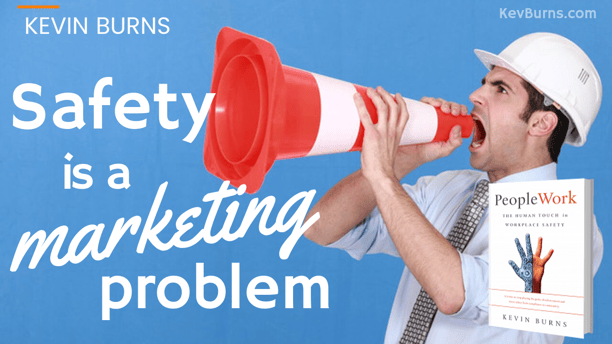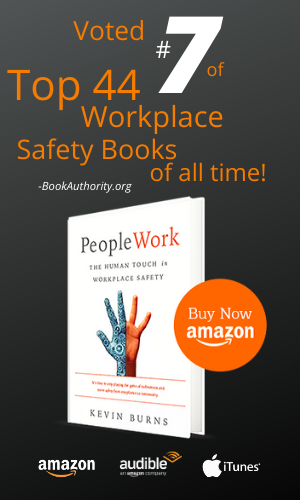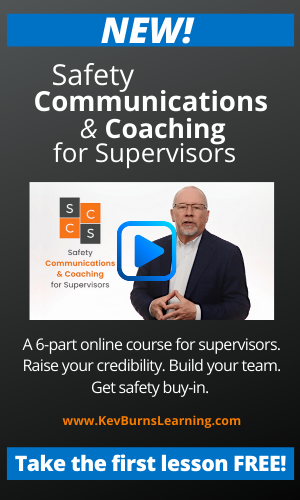Safety Is A Marketing Problem
Safety is not a process problem. It's a marketing problem.
 For fifty years, since the creation of the Occupational Health and Safety Act, we have been trying to get our people to embrace safety through mechanical means and clumsy attempts to scare them into safety (gruesome stories, gut-wrenching videos, fear and scolding). We’ve tried punitive rules enforcement, checkbox processes and procedures, and endless streams of paperwork. We create mind-numbing, PowerPoint-laden safety meetings and still get exasperated that we can’t seem to create employee buy-in. Had any of the above been the answer, surely something would have been successful by now. But these are all mechanical means and mechanical means don't create employee buy-in.
For fifty years, since the creation of the Occupational Health and Safety Act, we have been trying to get our people to embrace safety through mechanical means and clumsy attempts to scare them into safety (gruesome stories, gut-wrenching videos, fear and scolding). We’ve tried punitive rules enforcement, checkbox processes and procedures, and endless streams of paperwork. We create mind-numbing, PowerPoint-laden safety meetings and still get exasperated that we can’t seem to create employee buy-in. Had any of the above been the answer, surely something would have been successful by now. But these are all mechanical means and mechanical means don't create employee buy-in.
Employees don’t warm up to things that are impersonal and especially those things that are thrust upon them. People telling us what to do and how to do it doesn’t create camaraderie and trust. It creates distrust and us-versus-them.
Procedures and processes for safe operations are mechanical. Data, tracking and reporting is mechanical. Forms, inspections and hazard assessments are mechanical. Technology and real-time apps are mechanical. And sure, all of it is important to measure effectiveness but mechanical means don’t create motivation, or engagement or inspire improvement. (Seriously, has anyone ever been inspired to up their safety performance because the monthly TRIF rate improved by .004?) So, how can internal safety awareness marketing fix this and why is it important to your safety culture?
Safety engagement requires a new mindset
Never before in history have there been better process and procedure, data, tracking, reporting, forms, inspections, or technology. And yet, we are still hurting people. If more of our people would simply follow the tested processes and procedures, we would drastically reduce the number of incidents. So, it seems clear that we don’t need more rules and mechanical processes. We need to get more people to willingly and voluntarily embrace the existing rules and mechanical processes more consistently.
However, to do that requires a very different approach and mindset. If you'd like to get started on improving your ability to lead your team, then take the Free Preview of the Safety Communications & Coaching for Supervisors course. 40-minutes of video instruction, summary sheet download PDFs and a companion MP3 audio version to take with you on the go. And it's free to get started.
Safety is a marketing problem.
Marketing guru Seth Godin, author of 18 worldwide bestsellers, wrote the following in a recent blog post. Democracy is a marketing problem. Health is a marketing problem. Climate change is a marketing problem. Growing your organization, spreading the word, doing work you’re proud of – these aren’t engineering problems or economics problems. They’re marketing problems. That’s because humans make choices. If we live in a culture where people are free to choose, we’ve offered control over our future to others. When humans make choices – that’s marketing. Marketing isn’t about shortcuts, hustle or deception. Marketing is the art (and the science) of serving the people you seek to serve, to do better work by finding and satisfying needs. Marketing is the practice of making things better by making better things.
 Safety is a marketing problem. Getting people to choose the correct processes and procedures consistently is marketing. Getting them to complete, read and utilize the data, tracking and reporting is marketing. Getting people to engage in the forms, inspections and assessments is marketing. Getting them motivated to embrace and use the new technology is marketing. In other words, creating a safety infrastructure is mechanical. Getting employees to consistently use that safety infrastructure is marketing.
Safety is a marketing problem. Getting people to choose the correct processes and procedures consistently is marketing. Getting them to complete, read and utilize the data, tracking and reporting is marketing. Getting people to engage in the forms, inspections and assessments is marketing. Getting them motivated to embrace and use the new technology is marketing. In other words, creating a safety infrastructure is mechanical. Getting employees to consistently use that safety infrastructure is marketing.
Communications versus marketing
You rely too much on communications and not enough on marketing. The difference? Communication informs. But marketing moves people. Marketing creates action. Marketing causes choices to be made. Marketing creates momentum. Information just sits there.
Information-dump communications don’t build motivation to make better choices. Stats and graphs don’t inspire better teamwork or a willingness to look out for each other. Reviewing safety rules doesn’t inspire better quality and improve engagement. Data simply informs your people.
Clear, focused safety awareness marketing makes people want to be part of something special.
What do you want them to do with the information? Ask them to do something different. That’s marketing. Develop a call-to-action for the information. That’s marketing.
The great teamwork safety cultures are focused on getting every member of the team to help the other members of the team to win. How are you asking your people to help their teammates to work better and get better results? That's marketing. Are you setting new standards for how your team will work together? That’s marketing. Are you asking your team to buy-in to the vision and mission for safety and quality? That’s marketing. Are you demonstrating enthusiasm and caring for your people? That’s marketing too.
What is the idea, plan or vision that you are selling? What do you want them to do that they're not doing now? That’s marketing. Create a safety culture that is much more engaging and inspiring for the employee. Clear, focused safety awareness marketing makes people want to be part of something special.
-- Take the FREE preview lesson of Kevin's course Safety Communications & Coaching for Supervisors. 40-minutes of video instruction, summary download PDFs and a companion audio MP3 version to take with you on the go. SCCS is an online course to help energize safety, build teamwork, and get employee buy-in.
Take the FREE preview lesson of Kevin's course Safety Communications & Coaching for Supervisors. 40-minutes of video instruction, summary download PDFs and a companion audio MP3 version to take with you on the go. SCCS is an online course to help energize safety, build teamwork, and get employee buy-in.
Kevin Burns, consultant/author, works with smart, caring companies to energize safety culture, build teamwork, and get employee buy-in.
KevBurns Learning is committed to to helping companies improve safety by improving people, through creative learning materials, virtual strategy sessions, safety meeting presentations, and team coaching programs.
In 2020, BookAuthority.org named PeopleWork #7 of The Top 44 Workplace Safety Books of All Time. Buy yourself a copy of PeopleWork: The Human Touch in Workplace Safety and give another as a gift to a colleague.
Subscribe to Kevin's YouTube channel.
Subscribe to Kevin’s Blog.


